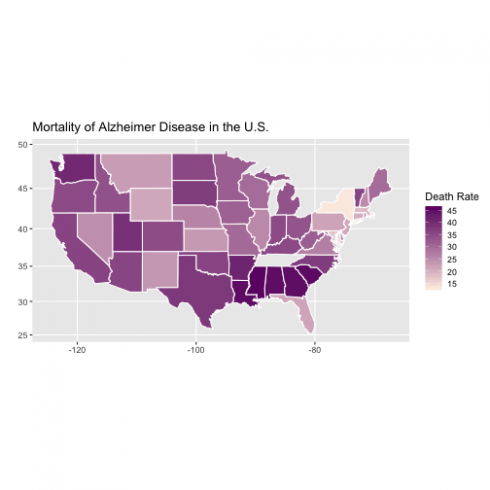In comparison with other statistical software (e.g., SAS, STATA, and SPSS), R is the best for data visualization. Therefore, in all posts I have written for DataScience+ I take advantage of R and make plots using ggplot2 to visualize all the findings. For example, previously I plotted the percentiles of body mass index in the NHANES 2005-2014 and got exactly same results as the paper published in JAMA.
In this post, I will make a map of the prevalence of Alzheimer disease mortality by the state in the USA. The Centers for Disease Control and Prevention is providing the data for download, and they have created a beautiful map. I will try to reproduce the same results using several packages in R.
Libraries and Datasets
Load the library
library(tidyverse)
library(scales)
library(maps)
library(mapproj)
CopyDownload the .CSV file from the Centers for Disease Control and Prevention website (link is above)
dt_ad <- read.csv("~/Downloads/ALZHEIMERS2016.csv")
head(dt_ad)
STATE RATE DEATHS URL
1 AL 45.0 2,507 /nchs/pressroom/states/alabama/alabama.htm
2 AK 25.8 111 /nchs/pressroom/states/alaska/alaska.htm
3 AZ 35.8 3,082 /nchs/pressroom/states/arizona/arizona.htm
4 AR 41.3 1,475 /nchs/pressroom/states/arkansas/arkansas.htm
5 CA 36.1 15,570 /nchs/pressroom/states/california/california.htm
6 CO 34.7 1,835 /nchs/pressroom/states/colorado/colorado.htmCopyLoad the map data of the U.S. states
dt_states = map_data("state") head(dt_states)long lat group order region subregion 1 -87.46201 30.38968 1 1 alabama2 -87.48493 30.37249 1 2 alabama Copy3 -87.52503 30.37249 1 3 alabama 4 -87.53076 30.33239 1 4 alabama 5 -87.57087 30.32665 1 5 alabama 6 -87.58806 30.32665 1 6 alabama
Now, I have two datasets, one has the rate of mortality from Alzheimer disease and the other have variables with the information to create maps. I need to merge both datasets together but I dont have a similar variable for merge. Therefore, I will create a new region variable form the URL variable in the first dataset and will use to merge with the second dataset. For this purpose, I will use the function separate and gsub. In the end I will merge with states dataset by region.
#get the state name from URL
dt_ad2 = dt_ad %>%
separate(URL, c("a","b","c","d", "region"), sep="/") %>%
select(RATE, region)
# removing white space for mergin purposes
dt_states2 = dt_states %>%
mutate(region = gsub(" ","", region))
# merge
dt_final = left_join(dt_ad2, dt_states2)
CopyVisualization
The dt_final dataset have all the variables I need to make the map.
ggplot(dt_final, aes(x = long, y = lat, group = group, fill = RATE)) +
geom_polygon(color = "white") +
scale_fill_gradient(
name = "Death Rate",
low = "#fbece3",
high = "#6f1873",
guide = "colorbar",
na.value="#eeeeee",
breaks = pretty_breaks(n = 5)) +
labs(title="Mortality of Alzheimer Disease in the U.S.", x="", y="") +
coord_map()
CopyIn this short post I showed how simple is to visualize the data in a map. I hope you like it and feel free to post a comment below or send me a message.
